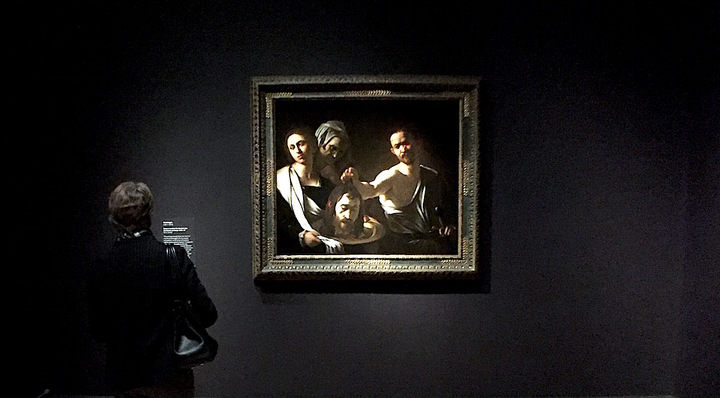Caravaggio – “What a man! What a painter, but what a man and what a believer.” Those are the words of François Bousquet, Rector of San Luigi dei Francesi in Rome, the church which, in the stunning Contarelli Chapel, houses the magnificent paintings which formed Caravaggio’s first major commission and made his reputation.
Bousquet makes his assertion in the introductory film to ‘Beyond Caravaggio’ at the National Gallery. They seem somewhat strange words to use of a man of whom, as Andrew Graham-Dixon has noted, “the majority of his recorded acts – apart from those involved in painting – are crimes and misdemeanours.” Insults, taunts, fights, and murder are all recorded of Caravaggio in the criminal archives of his time. He died as he lived, “badly, brutally,” in the words of Jonathan Jones. He was a violent man but in a violent world where his actions were by no means unusual, even or especially among artists. Graham-Dixon characterises him accurately as both sacred and profane.
Clearly, this doesn’t make him a ‘good’ Christian, but it is debatable as to whether any ‘good’ Christians exist, given that the recognition, confession, and forgiveness of sin is central to the faith.
A better question is what makes such a man one of the most significant artists in both art history and Church history. Why was he, as Jones suggests, “the only artist who was able to rekindle the flame of Italian genius that earlier in the 16th century had reached such peaks in the work of Leonardo and Michelangelo”?
He was a violent man but in a violent world where his actions were by no means unusual, even or especially among artists.
In answering that question we need to recognise that his consorting with the wretched of the cities, which resulted in his criminal actions and his need for the protection of the rich that he had impressed with his art, also informed, more positively, the theology of his art. His art was sensational not only because he made Bible stories look as though they were taking place in the here and now, in the street or tavern, but also because he populated them with the people of the street, the “prostitutes, rent boys, beggars” with which he consorted.
In his art, as Graham-Dixon notes, he was “explicitly welcoming the poor into his pictures, making them feel part of the same impoverished family as that of Christ and his followers” and, thereby, “implicitly calling on the rich to follow the example of those such as St Francis, the merchant’s son, and Elizabeth of Hungary, the princess, who had given away all their worldly possessions to minister to the poor.” As such, “he was firmly allying himself with the pauperist wing of the Catholic Church” in his day but, as this focus connects both with the reality of incarnation – that God moved into our neighbourhood – and also with what has been called God’s bias to the poor, his art taps deep seams of Christian spirituality which have continuing resonance in every age.
Caravaggio in his art tapped deep enduring veins of Christian spirituality while his personal life caused increasing issues for his patrons. He is, therefore, perhaps a precursor to one of the pressing issues in the contemporary relationship between the Church and the visual arts, which is the extent to which the Church should commission those artists who have a personal faith commitment regardless of the extent of their reputation or the best artists of the day, regardless of their personal faith commitment or lack of. This issue arose in part because of the separation which was perceived to have developed between the artistic avant-garde in the modern period and the Church, leading to churchmen, such as Canon Walter Hussey in Britain and Père Marie-Alain Couturier in France, expressly commissioning so-called ‘secular masters’ from Henry Moore to Henri Matisse. Many of these commissions attracted virulent criticism either because of the modernity of the images clashed with traditional iconography or because some thought it inappropriate for artists who were atheists, communists or of other faiths to be creating work for Christian churches. Some were thought to be so controversial that, like the crucifix commissioned by Couturier from Germaine Richier at Assy, they were, for a time, removed by the Church authorities.
There are, therefore, parallels for clerics in the difficulties raised by such commissions, as was the case, too, for those who commissioned the controversial Caravaggio. However, just as the commissioning of Caravaggio resulted not only in new artistic innovations but also new spiritual insights, so the commissions by Hussey, Couturier, and others have also often resulted in new perspectives on traditional understandings of Christian theology precisely because the artists commissioned have viewed traditional theology with fresh eyes.
Caravaggio cannot be viewed as a ‘good’ Christian but the idea of ‘good’ Christians is no relevance to a faith built on the need that all have for forgiveness. Christianity is nothing, if not a faith for second chances and new opportunities. Caravaggio’s art remains potent for Christians because of the incarnational basis of its pauperist spirituality. As a result, his life and art is a demonstration of the value to the Church of commissioning art that is both innovative and controversial when those creating such art reveal an understanding of the wellsprings of Christian spirituality and theology.
Words: Revd Jonathan Evens Priest-in-charge St Stephen Walbrook Photo: Paul Carter Robinson
* A. Graham-Dixon, ‘Caravaggio: A Life Sacred and Profane’, Penguin, 2010;
* J. Jones, ‘Caravaggio: He lived badly, brutally’, The Guardian, 17 February 2005.

